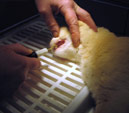National Pet Dental Month
Eighty percent of dogs and cats show oral disease by age 3, and it is the most common health problem treated in small animal health clinics today. The build-up of bacteria in your petís mouth may cause more than just bad breath. Bacteria is also the cause of oral disease and diseases in other organs like the heart, liver and kidneys.
 DENTAL TARTAR
DENTAL TARTAR Just like humans, petís teeth are prone to plaque build-up, and when allowed to combine with saliva and residual food between the tooth and gum, plaque turns to tartar. If plaque and tartar are not removed routinely by your Veterinarian, they may cause periodontal disease.
Dogs and cats get common dental problems such as dental plaque tartar, gum and tooth disease. Itís important to understand the differences between plaque, tartar and periodontal disease and how to prevent them.

PLAQUE
Dental plaque is a sticky substance that covers the teeth. It consists of bacteria, saliva, food particles and epithelial cells. Plaque builds up on the tooth surface and gum line every day. Left undisturbed the plaque can mineralize, or harden, in less than 2 days, forming calculus or tartar. Plaque can get worse where teeth are closer together, which will result in bad breath.

TARTAR
Dental tartar is a film that covers teeth consisting of calcium phosphate and carbonate, food particles and other organic matter. The tartar will stick to the tooth surface forming a scaffold for more plaque accumulation. The continued build-up of tartar both above and below the gum line can eventually produce an environment that is a haven for certain types of bacteria that may be more destructive to the periodontal tissues and also produce a more noticeable odor. This can lead to periodontal disease.

GINGIVITIS
Gingivitis is an inflammation of the gums most commonly caused by the accumulation of food particles in the crevices between the gums and teeth. The main symptom is bleeding, although you may also notice redness, pain and difficulty in chewing. If gingivitis is not treated, it may lead to periodontitis.

PERIODONTAL DISEASE
Periodontal disease is a very common infectious disease caused by bacteria that make up plaque. This results in inflammation of the structures that support teeth, the gum tissue, periodontal ligament, alveolus (small cavity) and cementum (bonelike connective tissue covering the root of a tooth and assisting in tooth support). Symptoms of periodontal disease include bad breath and red or inflamed gums. There are other signs of dental disease in your pet that may be more subtle.
Pets may preferentially choose softer foods; play with chew toys less and decline crunchy treats. You may also notice your pet chewing more on the sides of his mouth. He may chew less in general and this sometimes causes the pet to vomit, seen as undigested or poorly chewed food. Increased salivation, pawing at or rubbing the face can be another indication of oral pain.

BROKEN TEETH
Broken teeth are a common problem. Most commonly caused by aggressively chewing on hard objects.
 |  |
 Preventing Oral Disease:
Preventing Oral Disease: As an owner you want to start your pets on the road to good dental health. Start by choosing the right dental product, helping your pet achieve healthy mouth.You should have your petís teeth and gums checked by your Veterinarian. At home, it is important to remember not to use human toothpaste or baking soda. Both can make your pet sick. There are different products available to clean your pet's teeth, including gels, toothbrushes, toothpaste, CET Chews, Dental Kongs and even diets. Deciding on which one to use often depends on the temperament and age of your dog or cat.
Starting off pets when they are young is the best way to get them to accept regular teeth cleaning. Dental care can begin around 3 to 4 months of age. You can get your kitten or puppy used to having his teeth cleaned by gently rubbing and massaging them with a piece of gauze wrapped around your finger.
Prevention is easy as daily brushing that will remove the plaque, prevent tartar and eventual periodontal disease.

Dental Procedure:
A dental, also sometimes called a "prophy" or prophylaxis, is a cleaning and polishing of a pet's teeth. It is important to realize that dental disease does not reach a particular level and remain there. Dental disease continuously progress. As dental disease progresses, the treatment becomes more involved, meaning longer and more elaborate (and more costly) dental procedures. This means that sooner is better than later when it comes to addressing your pet's dental disease with an appropriate treatment.

Brushing Teeth:
Dental disease is the most common disease in our feline companions. It is also one of the most preventable and treatable disease. We can reduce or even prevent dental disease by feeding a crunchy diet and daily teeth brushing. The following are steps to guide you on how to brush your pet's teeth:

Features to Consider in Petís Toothpaste:
 Desirable Features in Petís Toothpaste:
Desirable Features in Petís Toothpaste:
 Shopping & Safety Tips for Buying Pet Toothpaste:
Shopping & Safety Tips for Buying Pet Toothpaste:
 |
| CET Pet Toothpaste | CET Toothbrush | Greenies |
| NEW! Ora-Clens | SpotScent | Easy Brush |
| Edible Dental Brush | Dentees Chews | OraVet Treatments |
